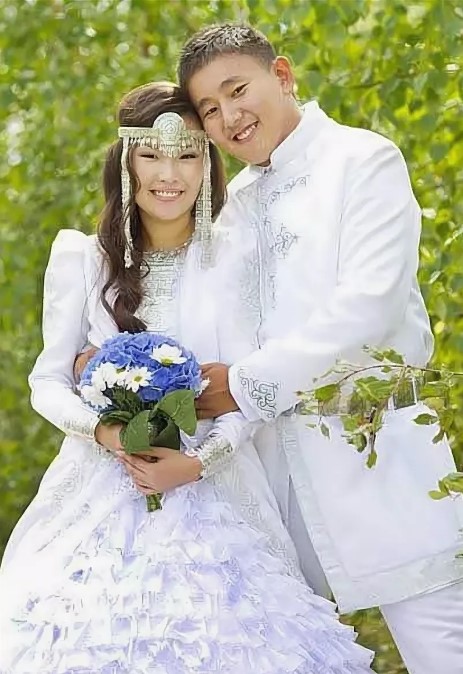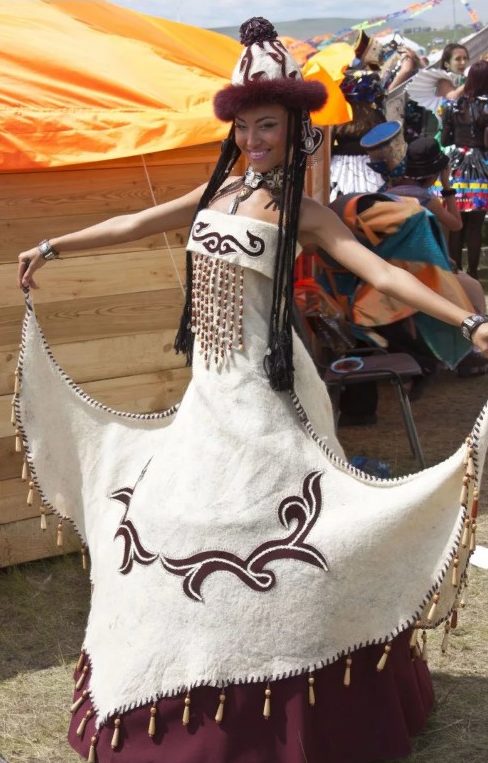 The characteristic features of the national costumes of the peoples of Siberia are determined by natural and climatic conditions and the characteristics of economic activity. Such outfits, both everyday and festive (including wedding), have a fairly pronounced ethnic specificity, manifested in the material used, cut features, decorations and placement of decorative elements.
The characteristic features of the national costumes of the peoples of Siberia are determined by natural and climatic conditions and the characteristics of economic activity. Such outfits, both everyday and festive (including wedding), have a fairly pronounced ethnic specificity, manifested in the material used, cut features, decorations and placement of decorative elements.
Traditional wedding costumes in different parts of Siberia
Yakuts
Yakuts admit one of the most numerous Siberian peoples and are among the nationalities with a complex ethnic formation. According to archaeological data, the Yakut people are the result of a mixture of local tribes living along the middle reaches of the Lena River with southern Turkic-speaking settlers. After some time, the nation thus formed split into several different groups (reindeer herders of the north-west, etc.).

Representatives of this ethnic group live in small families in the Krasnoyarsk, Khabarovsk and Irkutsk regions, but mainly in the Republic of Sakha. Their main activities include hunting, fishing, and raising horses and cattle. An important place in the beliefs of the Yakuts is given to the veneration of nature. Many of the ancient rituals and traditions of this people are observed by the Yakuts today.
Yakut wedding dresses were previously sewn exclusively from natural materials. Currently this condition is not mandatory.

Important! The bride's dress was white, symbolizing purity and purity.
The classic version of a women's Yakut wedding dress consists of the following parts:
- annah – veil (a special piece of fabric covering the face);
- body shirt made of rough rovdug;
- tight belt;
- leather trousers (natazniki);
- leggings - special leggings made from the skin of a wild animal (in appearance they look a little like boots, but do not have a foot part and end at the ankles);
- wedding fur coat - a toe-length fur coat richly decorated with brocade, silver jewelry and braiding with a hem lined with sable fur, widening at the bottom;
- national fur headdress with a high top made of red or black decorated cloth, reminiscent in appearance and cut of a military helmet;
- various decorations.

Reference! Wedding fur coats among the Yakuts are inherited.
Men's suits look much more modest compared to women's.. Their main feature is the fur trim on the collar and sleeves. Headgear is also made in the form of a helmet.

Modern Yakut wedding
Buryats
The most ancient people of the Baikal region (Eastern Siberia), currently living primarily in the Republic of Buryatia, Trans-Baikal Territory, and Irkutsk Region. Initially, cattle breeding was considered the predominant branch of the traditional Buryat economy, but later the Buryats began to devote more time to arable farming.

Reference! The main factor in shaping the lifestyle, morality and national psychology of this people was the Tibetan form of Buddhism - Lamaism.
Initially, improvised materials were used to sew costumes:
- wool;
- Genuine Leather;
- sheepskin;
- fur (sable, arctic fox, fox and others).

Later, with the advent of trade relations, outfits began to be made from velvet, cotton and silk, and jewelry from gold, silver and stones.
Women's wedding dress - the delegay was worn over the dress. The front part remained open, and there was a slit at the back hem. Often, the bride wore a festive outfit to her wedding, similar to those worn by married women.

The bride's wedding attire was made of brocade (azaa mangal), semi-brocade (mangal), thin silk (khorgui torgon) or chesuchi (shershuu). Winter versions were made with a fur coat lining, and summer ones with a cotton fabric lining.

Mandatory elements of the wedding attire were also a high-crowned headdress and chest, shoulder, temple and side decorations.
Groom's wedding dress consisted of swinging long-skirted clothing with a sash and a pointed headdress with a denze top. The costume and headdress were made from blue and blue fabrics. They belted their clothes with a colored sash or a belt with silver plates.

Nowadays, modern models of wedding dresses in the national style are very popular.
Khakassians
Traditions and legends connect the origin of the Khakass ethnic group with the Yenisei Kyrgyz. Since ancient times, this people inhabited the taiga territories of Southern Siberia in the valley of the Middle Yenisei. Khakassians are distinguished by their endurance, unpretentiousness and perseverance in achieving their goals. For many centuries, the life of this people was closely connected with religious cults based on interaction with nature.

Wedding clothes for the bride Khakassians sewed from expensive imported Russian and Chinese fabrics. The bride's wedding attire consisted of a women's festive shirt, black cloth outerwear embroidered with colored silk (sikpen), and a wedding hat, under which a scarf was worn.

A mandatory element of the wedding attire of Khakass women was a bib (pogo), considered a strong amulet that protected against evil spirits. The base of such a bib was a hemispherical piece of tanned leather covered in velvet with rounded horns. Mother-of-pearl round plates were sewn onto the front part of the bib. The space between them was filled with coral, beadwork and cowrie shells. The lower edge was decorated with a fringe of silberge beads with small silver coins at the ends. Pogo was considered one of the most expensive decorations (the cost of such a bib was higher than the cost of a luxurious fur coat).

Wedding fur coat It had a straight cut with deep armholes. At knee height, it gathered into gathers on the sides and back. The hem of the fur coat at knee level on the sides and back was quilted with nine, eleven or thirteen rows of thread. The lower part of this product resembled a skirt. The wedding fur coat retained heat well, but walking in it was quite uncomfortable. Over the fur coat they wore a short sleeveless vest (sigedek) with a lining and embroidered with silk threads.

The wedding dresses of the peoples of Siberia are quite practical, and are maximally adapted to the peculiarities of local climatic conditions. But at the same time they are very original, and are distinguished by rich decoration. To decorate their costumes, the peoples of Siberia use fur mosaics, beads, colored cloth, deer neck hair, long white dog hair, painted tassels, straps, metal pendants and bells.


 0
0






Cool costumes and everything